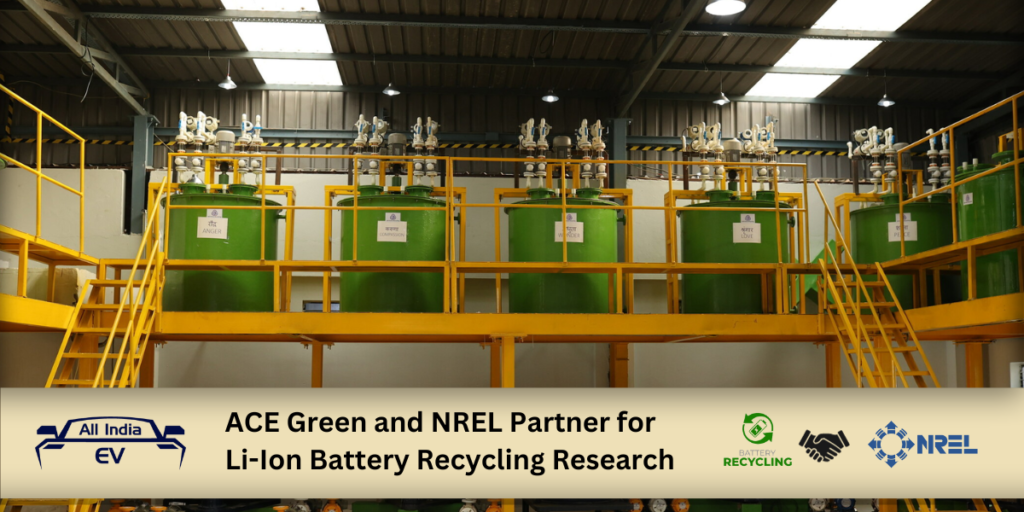ACE Green and NREL Partner for Li-Ion Battery Recycling Research
ACE Green and NREL Partner for Li-Ion Battery Recycling Research ACE Green Recycling (ACE) and the U.S. Department of Energy’s National Renewable Energy Laboratory (NREL) have agreed to work together on a project. The project is about making ACE’s battery recycling technology better and cheaper. The technology recycles old batteries that have graphite, lithium-iron phosphate (LFP), and other materials inside them. This project shows that the U.S. Department of Energy cares a lot about recycling batteries in a way that is good for the environment and the economy. Green Recycling ACE NREL is a DOE national laboratory specializing in energy efficiency and renewable energy research and development. It is situated in Golden, Colorado. NREL is dedicated to the creation and use of significant advancements in battery recycling technology as part of its mission. Due to the reduced cost of LFP batteries compared to Nickel and Cobalt based batteries, major automakers like Ford and Tesla are beginning to switch to LFP in the upcoming years, which will lead to a large increase in the number of electric vehicles based on these batteries. However, because it is so difficult to remove the valuable elements (graphite and lithium) from LFP batteries profitably, the industry views recycling LFP batteries as a particularly tough task. The volume of LFP batteries based electric vehicles is primed to grow significantly in coming years with major automobile manufacturers like Tesla and Ford starting to switch to LFP from Nickel and Cobalt based batteries due to its lower cost. However, LFP battery recycling is seen by the industry as a particularly challenging problem due to the difficulty in extracting its valuable materials (lithium and graphite) profitably. “Current hydrometallurgical recycling methods focus on extracting high-value materials from LFP batteries, such as lithium and copper,” said Andrew Colclasure, NREL. “To encourage a more holistic approach to recycling, we must demonstrate efficient processes that also recycle low-value materials such as graphite and iron-phosphate into commercially viable products. We look forward to working alongside our industry partners to advance low-cost recycling technologies to make the process more economical and environmentally friendly.” For the purpose of recycling LFP batteries, ACE has already developed a proprietary technique that is currently being scaled up commercially. As part of this research collaboration, NREL will help ACE assess whether to commercialize this method of upcycling graphite to battery grade and recycling LFP batteries. “Current hydrometallurgical recycling methods focus on extracting high-value materials from LFP batteries, such as lithium and copper,” said Andrew Colclasure, NREL. “To encourage a more holistic approach to recycling, we must demonstrate efficient processes that also recycle low-value materials such as graphite and iron-phosphate into commercially viable products. We look forward to working alongside our industry partners to advance low-cost recycling technologies to make the process more economical and environmentally friendly.” For the purpose of recycling LFP batteries, ACE has already developed a proprietary technique that is currently being scaled up commercially. As part of this research collaboration, NREL will help ACE assess whether to commercialize this method of upcycling graphite to battery grade and recycling LFP batteries. “We are excited to work with the talented team at NREL in our journey to commercialize our lithium-ion battery recycling technology and help the United States move towards sustainable domestic battery materials supply chain,” Vipin Tyagi, co-founder and chief technology officer of ACE Under the terms of the agreement, ACE technology’s value proposition will be shown by NREL using its cell production, modeling, analysis, and other advanced tool capabilities. The major work will be carried out at NREL’s Colorado location. As a whole, the Under the terms of the agreement, ACE technology’s value proposition will be shown by NREL using its cell production, modeling, analysis, and other advanced tool capabilities. The major work will be carried out at NREL’s Colorado location. Using ACE’s technology, the project’s overall goal is to determine the best recycling parameters for LFP and graphite in order to maximize the performance and lifespan requirements of batteries built from recycled materials in comparison to those made from virgin materials. The United States now imports more than 60,000 MT of graphite electrodes; however, by using ACE’s technology to potentially upcycle graphite, the country may strengthen its technological and engineering leadership and lessen its reliance on foreign supply chains. The partnership between NREL and ACE aligns with the objectives of the recently unveiled Inflation Reduction Act, which supports the localization of vital material supply chains within the United States, among other important objectives. About ACE Green Recyclers The unique battery recycling technology platform ACE Green Recycling, situated in the United States, has created eco-friendly, modular solutions for recycling different types of lead-acid and lithium-ion batteries that have reached the end of their useful lives. In its capacity as a technology supplier, ACE collaborates with participants in the battery materials ecosystem to develop customized circular solutions that guarantee vital battery components stay in the nations producing battery trash. Forward-Looking Statements Some assertions in this paper about ACE’s technology capabilities and future commercial goals are forward-looking. The statements made are predicated on the current expectations of ACE and encompass various business and technical risks and uncertainties that may result in actual outcomes that are not consistent with the projected, implied, or described results in any forward-looking statement. These risks and uncertainties include, but are not limited to, regulatory approvals, unforeseen technological changes, uncertainties associated with technological development, scaling and roll out, intellectual property protection, and the availability and sources of third-party financing. Click here for more such informative insights Join the All India EV Community Content Credit: CISION PR NEWSWIRE
ACE Green and NREL Partner for Li-Ion Battery Recycling Research Read More »




